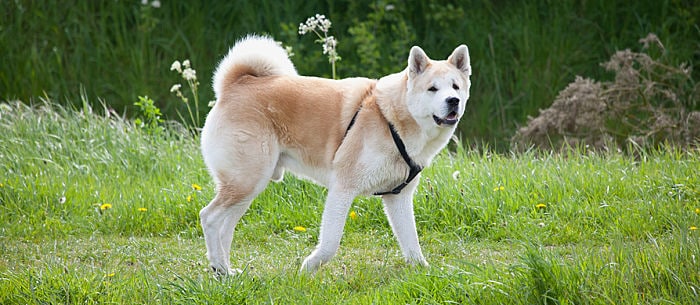A harness can help you keep your dog safe when you’re out for a walk or playing at the park. But it can sometimes be a struggle to wiggle your furry friend into a harness, especially if it has an abundance of confusing straps and clasps. Here’s everything you need to know about how to put on a dog harness properly.
Why Is It So Important to Know How to Put on a Dog Harness?
A harness that is placed or adjusted incorrectly can cause a slew of problems. For instance, your dog may feel the urge to pull against the harness in an effort to make himself more comfortable. In this scenario, you might think that your dog is misbehaving when he is actually just trying to ease the pain or discomfort that the harness is causing him.
Furthermore, “putting on a harness incorrectly can restrict the dog’s gait and cause tight muscles — especially if the dog has to change his body movement because the harness is restricting his range of motion,” says Alecia Evans, a holistic dog trainer. And, if the harness pulls too much to one side, it can also cause your dog to experience a structural imbalance, she adds. In addition, an improperly-adjusted harness can be a major safety hazard for your pet.
“The biggest issue that I’d worry about with a harness not being sized or fastened correctly would be the dog slipping out,” says David Wright, a dog trainer and the owner of iWorkDogs. This is a more common problem than you might think.
How Should You Put on Your Dog’s Harness?
There are two main types of harnesses: step-in harnesses and overhead harnesses. Here are step-by-step instructions on how to put each type on your dog.
Step-In Harness
- Unbuckle the harness and lay it on the ground.
- Have your dog stand over the harness.
- Place one of your dog’s front paws in one of the loops and his other front paw in the other loop. If your harness indicates which loop should match up with each foot, be sure to follow those instructions.
- Snap the strap buckles together on your dog’s back.
Overhead Harness
- Slip your dog’s head through the neck piece.
- Pull the bottom straps down under his belly and the top strap across his back.
- If your harness is connected on one side, have your dog step through the loop and then clasp the side straps together on the other side. If your harness is not connected on one side, be sure to clasp the straps on both sides.
Where Should You Place the Straps?
After you put on your dog’s harness, you need to check the strap placement. “All harnesses should fit below the neck and never put pressure on the dog’s throat,” says Evans. “A harness chest strap should also never go across the dog’s shoulder joint because it will inhibit the dog’s shoulder stride and thus their leg length stride.”
Make sure that the harness is high up on your dog’s chest, but down below his throat. You should also check that the side straps go up and around his shoulder, as this will help to avoid injury.
How Should You Adjust It?
Finally, you should adjust the straps to ensure that the harness is secure, but not too tight. You should use the buckles to tighten the straps until they get to a point at which you can fit two fingers between your dog and the harness.
Before you head out, you should double-check a few things in an effort to make sure that the harness is placed and adjusted properly. “First, check all the appropriate straps and buckles to make sure they’re fastened correctly,” says Wright. “Next, try to move the harness side to side and make sure it doesn’t slide over too far to one side or another.” Lastly, you should make sure that it’s not constricting your dog’s movement or rubbing against his skin.
The final product should look something along the lines of this photo, in which the dog is comfortable, relaxed and ready to go!
One final piece of advice is to use a little self-assurance throughout the process. “Put it on gently, calmly and confidently,” says Evans. “If you trust the harness and yourself, your dog usually will too.”
Read 6 Leash Training Tips You Won’t Learn in Obedience School for more information about walking your dog.
Rebecca Desfosse is a freelance writer who specializes in parenting, family and pet care topics.

